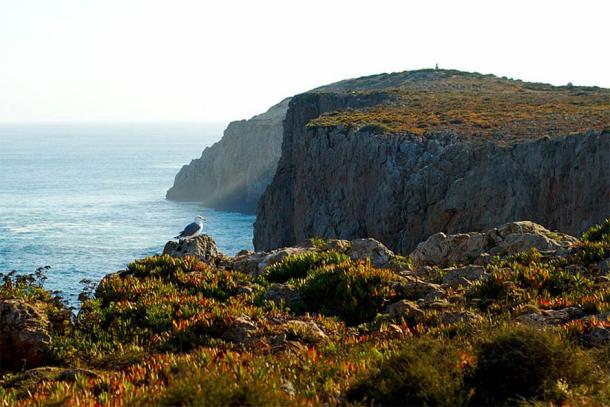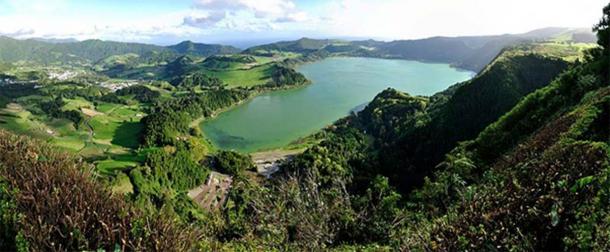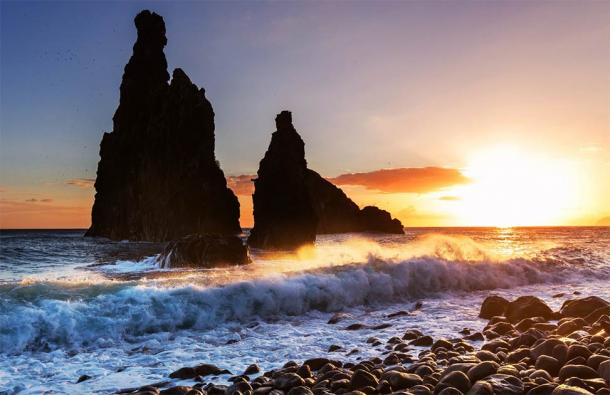Mice Remains Indicate a Viking Visit to Madeira
In a recent article on the Vikings in South America , it was indicated how scientists had put forward an untenable theory to account for the presence in Chile of the Bundsö dogs from Denmark before Columbus. I was proposed that this had been done in order to protect the academic dogma that Columbus was first to the Americas. Similarly, this present report highlights a strange new omission that is evidence of a Viking visit to Madeira.
Science now accepts as reasonable the probability that Vikings from Denmark and Schleswig reached the Atlantic island of Madeira. Such a voyage does not challenge the Columbus dogma directly. Accordingly, almost five hundred years before the voyage of Columbus, it would seem that Viking boats reached the farthest point south of their Atlantic explorations known to date by being 869 km (540 miles) south-west of Sagres, the southernmost tip of Portugal, and 876 km (545 miles) west of Casablanca.
Viking Activities on the Iberian Atlantic Coast
The evidence for Viking activities along the Atlantic coast of Iberia after 861 AD is sparse for the best part of the next hundred years until the raids picked up again from 960 AD. Two examples of these raids are those which occurred in 966 AD when 28 Viking boats attacked Lisbon, and another in 968 AD according to Historia Silense , when Gundered sailed a fleet of one hundred ships of Norsemen and Flemings against the coast of Galicia, northern Spain.
Into the eleventh century there were many minor raids, such as against the Portuguese coast in 1008 and 1016, and Olaf Haraldsson , later King Olaf II of Norway, led a fleet to raid Asturias and Galicia while on his way round to Jerusalem in 1015 AD. As the Viking Age drew to its close and the Scandinavians were gradually converted to Christianity, it was not unusual for Norsemen and Normans to attack the Atlantic coast of Iberia on their way to the Holy Land for pilgrimage or the crusades.
Although the Vikings must have overwintered somewhere on the coasts of Iberia, until recently no evidence had been found of a temporary safe haven where they might have done so. However, during a storm in March 2014 several Viking anchors were washed ashore in Galicia on a beach whose location is as yet a closely guarded secret.

Sagres, Portugal. ( CC BY-SA 2.0 )
The attention of the archaeologists was drawn to a large mound thought initially to have been a “motte-and-bailey” construction used by the later Vikings on the French coasts, but is more likely have been a “longphort” or ship-camp of a design found only in Ireland during the early Viking Age.
A longphort was an enclosure or shore fortress probably used as a base for raids. Viking marauders would look for an area to fortify along a river tributary, protected on both sides as a safehaven for the fleet. A fjord or similar would be best of course, being easily defended, sheltered and give immediate access to the sea. Galicia has a rocky coastline and fjord-like inlets surrounded by afforested hills (the “Rias Baixas”) and it would be surprising if the Vikings did not operate from hidden bases there.
Possible visits to the Azores by Norwegian Viking Ships
The historian Kelly Jr. J. E. in his 1979 volume “Non-Mediterranean Influences that shaped the Atlantic in the Early Portolan charts”, Imago Mundi 31, 18-35, speculated on the basis of medieval maps and Scandinavian texts that “Norwegian Vikings may have found their way to the Azores”.
The important modern scientific work for the Azores is by Gabriel, Mathias and Searle: ” Of Mice and the Age of Discovery: The complex history of colonization of the Azores archipelago by the house mouse (Mus Musculus) as revealed by mitochondrial DNA variation ” (J.Evol Biol, 14 November 2014).
Genetic studies found house mice of Norwegian ancestry at the Azores islands of Terceira and Santa Maria. The mice bones examined at the latter were predominantly clade F in contrast to the most common Azores clades B, C and D.
It is noteworthy that clade F, which has a geographical range that matches within the realm of influence of the Norwegian Vikings (including coastal Norway, north and west Scotland, Ireland and Iceland) has been found in neither Portugal or southern Spain, nor in the neighboring archipelago of Madeira and the Canary Islands.
Despite the extensive work carried out investigating fossil mice of clade F in the Azores islands, the extraordinary fact emerges that no carbon dating of clade F has been carried out, or as one may suspect, it may have been decided not to reveal the result because the Azores are too close to the Americas for comfort. Therefore no proof exists of the Viking stay in the Azores if there was one.

The Azores in Portugal. ( CC BY-SA 3.0 )
The Viking Presence on Madeira
As noted, the Atlantic island of Madeira lies 869 kilometers (540 miles) south-west of Sagres, the southernmost tip of Portugal, and 876 kilometers (545 miles) west of Casablanca. The research article by the Royal Society (Proceedings B) published on 7 April 2014 and entitled “Radiocarbon evidence for the presence of mice on Madeira Island (North Atlantic) one millennium ago” provides us with the scientific report on which the belief in the Viking presence on Madeira is based:
“New surveys in Ponta de Sao Lourenco have allowed us to obtain and date fossil bones of mice. The date obtained (1033 plus or minus 28 PB) documents the earliest evidence for the presence of mice on the island, suggesting that humans reached Madeira before 1036 cal AD, around four centuries before Portugal colonized the island.”
Radio carbon dating of samples of mus musculus domesticus carried out at the University of Oxford gave the result that the mice examined had lived sometime between 900 and 1030 AD and show similarities with house mice of Scandinavia and northern Germany (but not the Portuguese mainland). These mice had travelled there somehow.
Scientists discounted the possibility as highly improbable that birds could have carried the mice there from Scandinavia, or that the mice washed up there from Denmark on driftwood. The evidence provides northern Europe as the source and indicates the “intriguing possibility” that the mice must have stowed away on Viking ships.

Madeira Coast ( Galyna Andrushko / Adobe Stock)
Conclusion
There are no historical references of Vikings travelling to Madeira and therefore no indication of where the Madeira voyagers were bound next from there. It is highly unlikely, however, that a Viking fleet supposedly “heading for the Holy Land past Gibraltar” would have been blown so far off course by the elements as five hundred miles south as one commentator imagined.
In the previous article on the Viking expansion to the South in this same era, evidence was offered that Vikings from the Danelaw and Schleswig, coming from Europe, disembarked at Santos on the coast of Brazil and proceeded inland from there. It is tempting to conjecture that on the way they made an intermediate stop at Madeira for water, fish and game, ran their boats up on the beach and the mice went ashore.
Something of which one can be fairly certain is that Danish and Schleswig Vikings were some of the first Europeans to reach Brazil. The following was reported by Jacques de Mahieu in La Agonía del Dios Sol in 1977. A Danish boat heading back to Brazil on a round voyage in the mid-13th century took aboard a passenger in Normandy, Father p.Gnupa, a Catholic missionary. The priest wrote about this voyage and his subsequent activities in Brazil. He disembarked on the huge island of Marajó, a major Viking support station at the mouth of the Amazon.
After a Danish boat arrived in Normandy with a cargo of Brazil wood, it was as from then that the customs houses of Dieppe, Caen and Harfleur would draw up regulations regarding the importation of these tree trunks from the Amazon. In any case, the Norman caravel was far superior to a Viking drakkar with a square sail and by 1250 AD and the end of the Viking Age, the Normans would have been able to dominate the imports of wood from Brazil to Normandy. The history books would have the French arriving much later, with the Norman Binot Palmier de Gonneville making the first confirmed voyage to Brazil in 1504. But surely commerce must have been precluded by exploration. More evidence is needed, but it certainly seems possible this will come with time.
Related Post
A shocking documentary proves that mermaids do exist
SHOCKING Revelation: Thuya, Mother of Queen Tiye, Was the Grandmother of Akhenaten and Tutankhamun—What Ancient Egyptian Secrets Did She Leave Behind?
Breaking News: Astonishing Discoveries at Karahan Tepe Confirm an Extraterrestrial Civilization is Hiding on Earth, and NO ONE Knows!
Breaking News: Researchers FINALLY Discover U.S. Navy Flight 19 After 75 Years Lost in the Bermuda Triangle!
NASA’s Secret Investigation: Uncovering the Astonishing Mystery of the UFO Crash on the Mountain!
Explosive UFO Docs LEAKED: Startling Proof That Aliens Ruled Ancient Egypt!